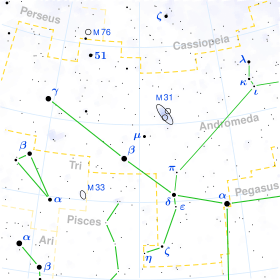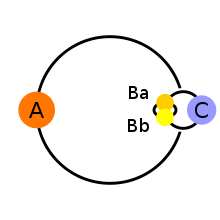Gamma Andromedae
 | |
| Observation data Epoch J2000.0 Equinox J2000.0 (ICRS) | |
|---|---|
| Constellation | Andromeda |
| Right ascension | 02h 03m 53.9531s[1] |
| Declination | +42° 19′ 47.009″[1] |
| Apparent magnitude (V) | 2.10[1] |
| Characteristics | |
| Spectral type | K3IIb[2] |
| U−B color index | +1.58[2] |
| B−V color index | +1.37[2] |
| R−I color index | +0.68[2] |
| Astrometry | |
| Radial velocity (Rv) | −11.7 ± 0.9[1] km/s |
| Proper motion (μ) | RA: 43.08[1] mas/yr Dec.: −50.85[1] mas/yr |
| Parallax (π) | 9.19 ± 0.73[1] mas |
| Distance | 350 ± 30 ly (109 ± 9 pc) |
| Absolute magnitude (MV) | −3.05[3] |
| Details | |
| Radius | 80[4] R☉ |
| Luminosity | 2,000[4] L☉ |
| Temperature | 4,500[4] K |
| Rotational velocity (v sin i) | < 17[2] km/s |
| Other designations | |
Almach, Almaach, Almak, Almaak, Alamak, γ1 And, Gamma1 Andromedae, Gamma1 And, γ Andromedae A, γ And A, Gamma Andromedae A, Gamma And A, 57 Andromedae A, 57 And A, STF 205A, ADS 1630 A, BD+41 395, CCDM J02039+4220A, FK5 73, GC 2477, HD 12533, HIP 9640, HR 603, IDS 01578+4151 A, PPM 44721, SAO 37734, WDS 02039+4220A.[1][2][5] | |
| Database references | |
| SIMBAD | data |
Gamma Andromedae (γ Andromedae, abbreviated Gam And, γ And) is the third-brightest point of light in the constellation of Andromeda. It is a multiple star system approximately 350 light-years from the Earth.
In 1778, Johann Tobias Mayer discovered that γ Andromedae was a double star. When examined in a small telescope, it appears to be a bright, golden-yellow star (γ1 Andromedae or γ Andromedae A, also named Almach[6]) next to a dimmer, indigo-blue star (γ2 Andromedae or γ Andromedae B), separated by approximately 10 arcseconds. It is often considered by stargazers to be a beautiful double star with a striking contrast of color.[7] It was later discovered that γ2 Andromedae is itself a triple star system. What appears as a single star to the naked eye is thus a quadruple star system.[7][8]
Nomenclature
- γ Andromedae (Latinised to Gamma Andromedae) is the system's Bayer designation; γ1 and γ2 Andromedae those of its two constituents. The designations of those constituents as Gamma Andromedae A and B derive from the convention used by the Washington Multiplicity Catalog (WMC) for multiple star systems, and adopted by the International Astronomical Union (IAU).[9]
- In 2016, the International Astronomical Union organized a Working Group on Star Names (WGSN)[10] to catalog and standardize proper names for stars. The WGSN approved the name Almach for the component Gamma Andromedae A on 20 July 2016 and it is now so included in the List of IAU-approved Star Names.[6]
- Almach was the traditional name (also spelt as Almaach, Almaack, Almak, Almaak, or Alamak), derived from the Arabic العناق (al-‘anāq),[11] "the caracal" (desert lynx).[12]
- Another term for this star used by medieval astronomers writing in Arabic was رجل المسلسلة (Rijl al Musalsalah), "Foot of The [Chained] Woman".[11]
- In Chinese, 天大將軍 (Tiān Dà Jiāng Jūn), meaning Heaven's Great General, refers to an asterism consisting of γ Andromedae, φ Persei, 51 Andromedae, 49 Andromedae, χ Andromedae, υ Andromedae, τ Andromedae, 56 Andromedae, β Trianguli, γ Trianguli and δ Trianguli. Consequently, γ Andromedae itself is known as 天大將軍一 (Tiān Dà Jiāng Jūn yī, English: the First Star of Heaven's Great General).[13]
- In the catalogue of stars in the Calendarium of Al Achsasi al Mouakket, this star was designated الخامس النعامة (Al Khamis al Na'amah), which was translated into Latin as Quinta Struthionum, meaning the fifth ostrich.[14][15]
- In the Babylonian star catalogues, γ Andromedae, together with Triangulum, formed the constellation known as MULAPIN (𒀯𒀳) "The Plough".[16]
- Astrologically, this star was considered "honourable and eminent."[17]
Stellar properties

| Observation data Epoch J2000.0 Equinox J2000.0 (ICRS) | |
|---|---|
| Constellation | Andromeda |
| Right ascension | 02h 03m 54.720s (B)[18] |
| Declination | +42° 19′ 51.41″ (B)[18] |
| Apparent magnitude (V) | 4.84 (BC combined) 5.5 (B) |
| Characteristics | |
| Spectral type | B9.5V/B9.5V (B) A0V (C)[20] |
| U−B color index | −0.12[19] |
| B−V color index | +0.03[19] |
| Astrometry | |
| B | |
| Radial velocity (Rv) | −14±5[21] km/s |
| Proper motion (μ) | RA: 37[21] mas/yr Dec.: −57[21] mas/yr |
| Parallax (π) | 9.19 ± 0.73[18] mas |
| Distance | 350 ± 30 ly (109 ± 9 pc) |
| Absolute magnitude (MV) | −0.3 (BC combined)[22] |
| Orbit[23] | |
| Period (P) | 63.67 ± 1.0 yr |
| Semi-major axis (a) | 0.302 ± 0.001″ |
| Eccentricity (e) | 0.927 ± 0.03 |
| Inclination (i) | 109.8 ± 5.0° |
| Longitude of the node (Ω) | 109.6 ± 5.0° |
| Periastron epoch (T) | B2015.5 ± 1.5 |
| Argument of periastron (ω) (secondary) | 183.4 ± 15.0° |
| Position (relative to γ1 And) | |
| Epoch of observation | 2004 |
| Angular distance | 9.6″ [5] |
| Position angle | 63° [5] |
| Other designations | |
| Database references | |
| SIMBAD | data |
γ1 Andromedae is a bright giant star with a spectral classification of K3IIb. It has an apparent visual magnitude of approximately 2.26.[2]
γ2 Andromedae, with an overall apparent visual magnitude of 4.84,[19] is 9.6 arcseconds away from γ1 Andromedae at a position angle of 63 degrees.[5]
In October 1842, Wilhelm Struve found that γ2 Andromedae was itself a double star whose components were separated by less than an arcsecond.[11] The components are an object of apparent visual magnitude 5.5, γ Andromedae B, and a type-A main sequence star with apparent visual magnitude 6.3, γ Andromedae C.[19] They have an orbital period of about 64 years.[23] Spectrograms taken from 1957 to 1959 revealed that γ Andromedae B was itself a spectroscopic binary, composed of two type-B main sequence stars orbiting each other with a period of 2.67 days.[24]
Almach as a name
USS Almaack (AKA-10) was the name of United States navy ship.
See also
References
- 1 2 3 4 5 6 7 8 "* gam01 And". SIMBAD. Centre de données astronomiques de Strasbourg. Retrieved August 19, 2008.
- 1 2 3 4 5 6 7 HR 603, database entry, The Bright Star Catalogue, 5th Revised Ed. (Preliminary Version), D. Hoffleit and W. H. Warren, Jr., CDS ID V/50. Accessed on line August 19, 2008.
- ↑ Anderson, E.; Francis, Ch. (2012), "XHIP: An extended hipparcos compilation", Astronomy Letters, 38 (5): 331, arXiv:1108.4971 [astro-ph.GA], Bibcode:2012AstL...38..331A, doi:10.1134/S1063773712050015. Cite uses deprecated parameter
|class=(help) - 1 2 3 Almach, Jim Kaler, Stars. Accessed on line August 19, 2008.
- 1 2 3 4 5 Entry 02039+4220, discoverer code STF 205, components A-BC, The Washington Double Star Catalog Archived 2006-02-20 at the Wayback Machine., United States Naval Observatory. Accessed on line August 27, 2008.
- 1 2 "Naming Stars". IAU.org. Retrieved 16 December 2017.
- 1 2 pp. 113–114, vol. 1, Burnham's Celestial Handbook: An Observer's Guide to the Universe Beyond the Solar System, Robert Burnham, New York: Courier Dover Publications, 1978, ISBN 0-486-23567-X.
- ↑ 01578+4151, database entry, MSC - a catalogue of physical multiple stars, A. A. Tokovinin, CDS database ID J/A+AS/124/75.
- ↑ Hessman, F. V.; Dhillon, V. S.; Winget, D. E.; Schreiber, M. R.; Horne, K.; Marsh, T. R.; Guenther, E.; Schwope, A.; Heber, U. (2010). "On the naming convention used for multiple star systems and extrasolar planets". arXiv:1012.0707 [astro-ph.SR].
- ↑ "IAU Working Group on Star Names (WGSN)". Retrieved 22 May 2016.
- 1 2 3 p. 36–37, Star-names and Their Meanings, Richard Hinckley Allen, New York: G. E. Stechert, 1899.
- ↑ p. 23, Star tales, Ian Ridpath, James Clarke & Co., 1989, ISBN 0-7188-2695-7.
- ↑ (in Chinese) AEEA (Activities of Exhibition and Education in Astronomy) 天文教育資訊網 2006 年 7 月 10 日
- ↑ Knobel, E. B. (June 1895). "Al Achsasi Al Mouakket, on a catalogue of stars in the Calendarium of Mohammad Al Achsasi Al Mouakket". Monthly Notices of the Royal Astronomical Society. 55: 429. Bibcode:1895MNRAS..55..429K. doi:10.1093/mnras/55.8.429.
- ↑ η Cet (Deneb Algenubi), θ Cet (Deneb Algenubi), τ Cet (Durre Menthor), ζ Cet (Baten Kaitos), and υ Cet, were Al Naʽāmāt, the Hen Ostriches See Star Name - R.H.Allen p. 160. In Al Achsasi Al Mouakket catalogue, η Cet as Aoul al Naamat or Prima Struthionum (the first ostrich), θ Cet as Thanih al Naamat or Secunda Struthionum (the second ostrich), τ Cet as Thalath al Naamat or Tertia Struthionum (the third ostrich), and ζ Cet as Rabah al Naamat or Quarta Struthionum (the fourth ostrich). υ Cet should be Khamis al Naamat or Quinta Struthionum (the fifth ostrich) consistently, but Al Achsasi Al Mouakket designated the title the fifth ostrich to γ Gam with uncleared consideration.
- ↑ Origins of the ancient constellations: I. The Mesopotamian traditions, J. H. Rogers, Journal of the British Astronomical Association 108, #1 (February 1998), pp. 9–28, Bibcode: 1998JBAA..108....9R.
- ↑ p.27, Star Lore of All Ages, William Tyler Olcott, G.P. Putnam's Sons, New York and London, The Knickerbocker Press, 1911
- 1 2 3 Component 2, HIP 9640, database entry, Hipparcos catalogue, CDS ID I/239.
- 1 2 3 4 5 HR 604, database entry, The Bright Star Catalogue, 5th Revised Ed. (Preliminary Version), D. Hoffleit and W. H. Warren, Jr., CDS ID V/50. Accessed on line August 19, 2008.
- ↑ Entry 02039+4220, discoverer code STT 38BC, The Washington Double Star Catalog Archived 2006-02-20 at the Wayback Machine., United States Naval Observatory. Accessed on line August 19, 2008.
- 1 2 3 4 "* gam02 And". SIMBAD. Centre de données astronomiques de Strasbourg. Retrieved August 19, 2008.
- ↑ From apparent magnitude and parallax.
- 1 2 Entry 02039+4220, Sixth Catalog of Orbits of Visual Binary Stars, William I. Hartkopf & Brian D. Mason, United States Naval Observatory. Accessed on line August 21, 2007.
- ↑ A Preliminary Study of the Spectroscopic Binary Gamma Andromedae B, L. A. Maestre and J. A. Wright, Astrophysical Journal 131 (January 1960), pp. 119–121, Bibcode: 1960ApJ...131..119M.
External links
- Almaak (Gamma Andromedae) at The Internet Encyclopedia of Science
- Image ALMACH
- Almaak on AstroDwarf
- Gamma Andromedae on WikiSky: DSS2, SDSS, GALEX, IRAS, Hydrogen α, X-Ray, Astrophoto, Sky Map, Articles and images